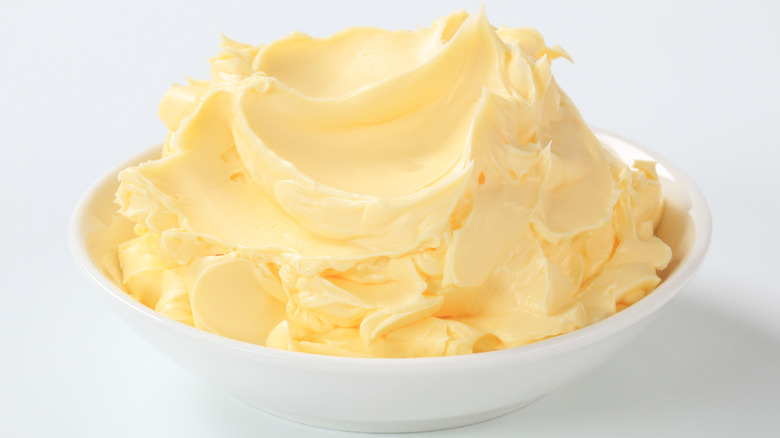The Finger Trick To Ensure Your Butter Is At The Right Temperature For Cake
Most cakes aren't difficult to make, but there are some rules and tricks to baking a cake that must be followed to produce the best bite possible. One of those rules is to ensure that ingredients are at room temperature before you begin to bake. Most importantly, you'll need to make sure your butter is at the right temperature for cake-baking. So, how can you tell if the butter is ready to start baking? Press your finger into the top of butter that's been sitting at room temperature. If it leaves a slight indent, it's ready to go. If your finger pokes through the butter or caused the butter to slide, it's way too warm.
No fingerprint? Let the butter warm a bit more before you start the creaming process. Once you learn what "room temperature" means, you'll be able to make most recipes without issue (and practice makes perfect).
What 'room temperature' actually means
Most recipes state that ingredients such as eggs, butter, and milk should be left at room temperature before starting to bake. But it's not obvious to a novice baker what this means.
"Room temperature" refers to the current temperature inside your home. But you also have to account for the fact that your kitchen may be warm as a result of a running oven.
Technically, room temperature means 65 to 67 degrees Fahrenheit, which is usually colder than the temperature inside of your home. To reach this temperature, butter has to rest on the counter for one to two hours before you begin baking. In baking, "room temperature" really means "warmer than your refrigerator, but not so warm that the ingredients melt." The reason behind bringing ingredients to room temperature is that cold ingredients don't blend well together, while warm ingredients mix (or emulsify) quickly.
Warming butter when time is a factor
It's ideal to leave ingredients on the counter for a few hours before baking, but there are some tricks to warming butter if you don't have all day to wait.
It might be tempting to use the microwave to warm ingredients. But the heat inside a microwave isn't even, which means parts of the butter may be cold and parts may be too warm.
Instead, place a large bowl of water in the microwave and heat the water for a few minutes. Then, place the butter inside the water and cover it. In a few minutes, you should be able to leave a fingerprint impression on the butter, and it will be ready to use. This method also works with cream cheese (just keep it wrapped). Before you begin your next baking project, bring the ingredients to room temperature and watch how well everything comes together.


